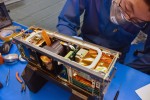A satellite built by 250 UCLA undergraduate students over the course of nine years successfully launched into orbit Saturday morning.
The Electron Losses and Fields Investigation is the first satellite built and operated entirely at UCLA. The program is currently made up of around 40 undergraduate students, who designed, manufactured, and tested the satellite, and three faculty members who mentored the students. ELFIN launched from Vandenberg Air Force Base, which is about 150 miles north of UCLA.
The satellites will help scientists monitor magnetic storms near Earth, which many experts still struggle to accurately predict. These storms can send electromagnetic waves to the earth and damage satellites used to gather information for GPS and weather monitoring.
The satellite is expected to stay in orbit for two years, at which point the satellite will burn up in the atmosphere. Until then, students will control and track the satellite via an antenna on top of Knudsen Hall. The ELFIN website will also allow the public to listen to the satellite as it orbits over UCLA twice a day.
The mission was funded by the National Science Foundation and NASA’s CubeSat Launch Initiative, which funds small satellite projects from universities, high schools and nonprofit organizations in the United States.
